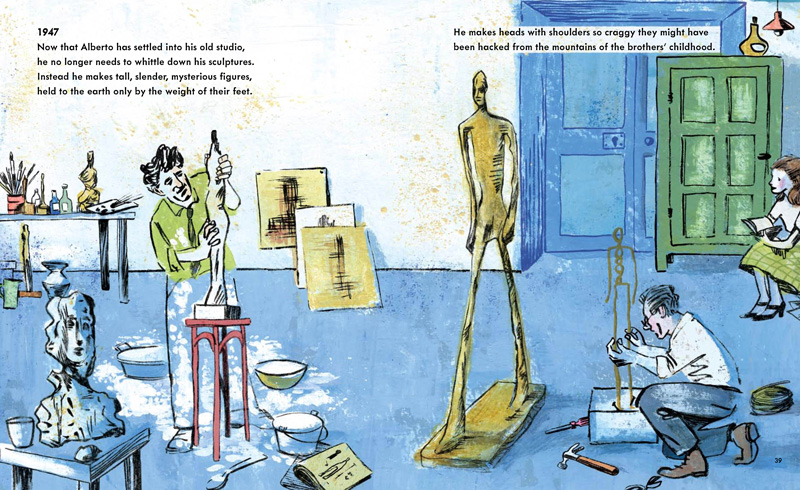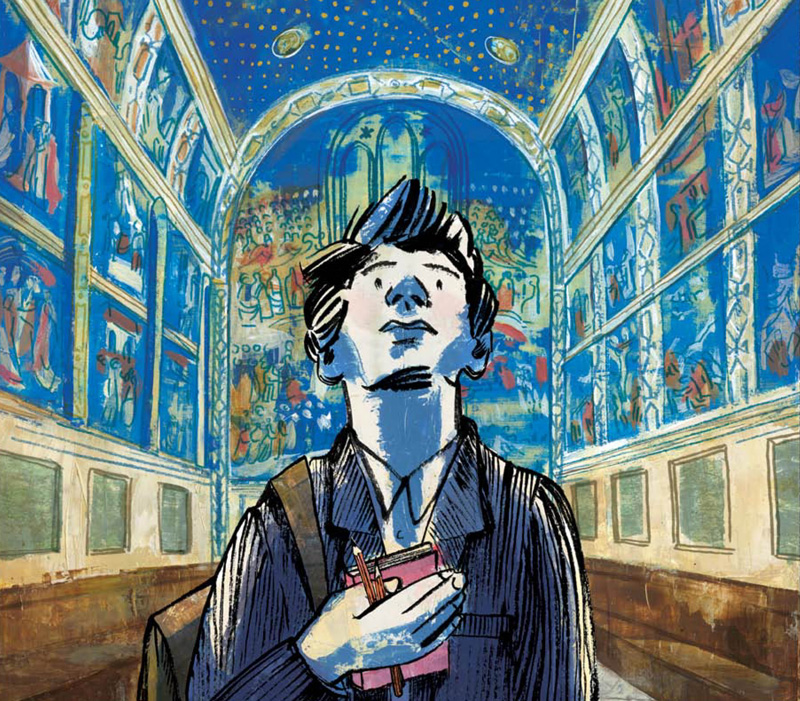 Alberto Giacometti is best known for his bronze sculptures: wiry, elongated figures in motion, “survivors [rising] courageously” from the “ruins of war.” Lesser known is the work of his brother Diego, whom Alberto took under his wing as an assistant and model, and who later became an expert in bronze casting, and a sculptor in his own right. In their latest collaboration, Two Brothers, Four Hands (Holiday House/Neal Porter Bks; Gr 4-7), Jan Greenberg and Sandra Jordan explore the life, work, and lifelong bond between these siblings, one of whom created some of the most iconic works of the 20th century. Mixed-media illustrations by Hadley Hooper capture the period, the personalities, and creative process in stunning detail. We spoke with the authors and the illustrator.
Alberto Giacometti is best known for his bronze sculptures: wiry, elongated figures in motion, “survivors [rising] courageously” from the “ruins of war.” Lesser known is the work of his brother Diego, whom Alberto took under his wing as an assistant and model, and who later became an expert in bronze casting, and a sculptor in his own right. In their latest collaboration, Two Brothers, Four Hands (Holiday House/Neal Porter Bks; Gr 4-7), Jan Greenberg and Sandra Jordan explore the life, work, and lifelong bond between these siblings, one of whom created some of the most iconic works of the 20th century. Mixed-media illustrations by Hadley Hooper capture the period, the personalities, and creative process in stunning detail. We spoke with the authors and the illustrator.
Collaborators discussing collaborators. Was it a natural fit?
Sandra Jordan: From our first scratchy notes made back in 2014, the Giacometti brothers’ tale arrived with its own insistent voice, and we both fell into it easily. I knew a lot about Alberto, less about Diego but there always is much research required between knowing about an artist or artists and being able to write about them. We didn’t have to look very far. Alberto is the star of the show, the magnetic talker who dominates the narrative, but you can’t read about Alberto without reading about Diego. He’s always there in the background, a vital part of the mix. And then, after great sadness, he gets his own moment, his time to shine.
The first draft came easily—and way too long—so we began the tough and exhilarating business of cutting. We made every possible cut and gave the results to our editor Neal Porter who said, “I love it. Genius. More cutting.” Agony ensued. I have a crowded section of the bookcase devoted to poetry and when we’re in this stage I often grab a random book from the shelves and read for a half hour. Not for any particular poet’s style but to energize the economy of language, the compression of images you find in poetry. After that you can only remind yourself that it is a picture book, and the art will bring a whole other level of illumination to the story. Hadley Hooper’s wonderful illustrations did that for us.
Despite the book's brevity, you cover so much—the brothers’ very different personalities, their childhoods and early lives, and the impact of the artistic trends and political events of the 20th century on Alberto Giacometti’s vision. Can you talk about your writing process here and your decision to frame the brothers’ story by decades or years?
Jan Greenberg: As collaborators, Sandra and I were particularly drawn to their story. The challenge was how to tell it in a book for children. We started to research, research, research. James Lord’s biography of Alberto Giacometti was very helpful, as were numerous other books about both brothers. Paris in the 1920’S and 1930’s was a gathering place for French intellectuals and great fun to read about. There were many wonderful anecdotes to choose from but our job was to choose the most important or revealing ones at each stage of their lives. Discussing Surrealism and WWII was challenging. Hadley Hooper’s illustrations were essential here and allowed minimum explanation. After all our research and discussion, we divided the story, each of us writing a different segment. Since we pass our work back and forth to read and revise, it was helpful to head each section by dates. Our editor liked the way this worked in the text. Sandra and I also felt that it would be a clarifying and informative device for our young readers.
In your books, you guide readers to look at art, really look, and provide a framework for them to do so. That’s true of Two Brothers as well. What is important to ask when young viewers are considering works of art?
JG: Most viewers stand before an artwork in a museum for 10 seconds, make a quick positive or negative judgment, and move on. In our first collaboration, The Painter’s Eye, Learning to Look at Contemporary Paintings, our goal was to get beyond “I like it or don’t like it” responses. Using a model for analyzing painting designed by a group of art educators, we adapted it for our young audience. We invited them to join us, pulling a painting apart one element at a time and putting the pieces back together again, like a jigsaw puzzle.
We began with simple questions. Look at this painting. What do you see? Is it a portrait, a landscape or a still life? We didn’t belabor art terms with long explanations- just a line or two and visual examples, such as a still life by Wayne Thiebaud of a hot dog or an abstract painting by Jackson Pollock. The ways the artist arranges the elements (color, shape, texture and line) to create visual effects, such rhythm or variety, are clues to the whole composition and how it works. This all leads to the most important question. “What is the feeling expressed in this artwork?” “How does it make you feel?” We stress there are no right or wrong answers. The conversation with art begins.
SJ: Art is part of being human, part of our DNA. Although every culture doesn’t paint or sculpt they decorate their houses, their bodies, they make their tools beautiful as well as functional. Follow five year olds around a museum and listen to them shout out their responses to what they are seeing. Older kids hang back. They’ve learned there are right answers and wrong answers. We say to our readers no right or wrong here. Look, really look. If you don’t get what’s going on, use the tools of color, shape, line, and texture to consider the work and then trust yourselves. Museums don’t exist to hide the art. The art is there for you.
I want our readers to enjoy looking at art, to let it enlarge their idea of life. [I want them to know that] artists fail all the time. The ones who are successful are the ones who keep trying. Alberto Giacometti had years of artistic “failure” before he began making the sculptures the world loves. His friend, the playwright Samuel Becket said “Try again. Fail again. Fail better.” I want [readers] to know that art is serious but it is also fun. I secretly hope they might even want to make some art themselves.
The illustrations for Two Brothers, Four Hands are so evocative of a period, a world at war, the artistic struggles of a 20th-century icon, and a relationship. How did you approach this project? What was your way in?
Hadley Hooper: Research! While I was finishing up another project I was reading a biography of Alberto. I love research so when I was full time on the book it meant hours reading every day and finding images of their sculptures, paintings, and environs. They were photographed by some of the 20 th-century’s most accomplished photographers so there were lots of likenesses to work from. I went to the library and the books I returned to again and again I ended ordering and buying.
By the time I put pen to paper, I knew them pretty well.
There are full-page, half-page, and three-quarter spread illustrations, and spot art, as well as overlapping images in Two Brothers. Can you talk about those choices, and your use of color?
HH: Some pages needed more visual information and some less and I wanted to make the page turns a surprise. We move through their lives pretty quickly so the visual shifts in layout don’t feel out of place (I hope).
In 1957, the writer and friend of Alberto’s, Jean Genet, described the studio as “a milky swamp, a seething dump, a genuine ditch”. It was full of every shade of gray and brown possible. But that would have been a bummer to page though, so there are lots of blues and greens standing in for those colors.
Your art is sophisticated, yet completely accessible to the book’s audience. Were there particular considerations that went into creating this art for a young audience?
HH: I wanted to create Alberto and Diego as relatable people. Annette [Alberto’s wife] as well, she really seemed to keep the wheels turning. I didn't want to simplify their depictions, I kept them pretty adult. The manuscript reflected this too, it was wonderful to work from. Their lives were full and complicated and messy; I really wanted to honor that.
Creating art for a book about artists, does that present a particular challenge?
HH: Yes, it’s tricky because I didn’t want to try and recreate Alberto’s painting style. First of all, I could never paint with that expertise, so that would have been folly. But I definitely studied his line. The way I work in my own painting with lots of applying, removing and sanding paint felt appropriate to use here. The result is that I felt connected in the act of ‘making’ but wasn’t copying.
 Jan Greenberg and Sandra Jordan introduce and share some of the backstory for creating Two Brothers, Four Hands, courtesy of TeachingBooks.net.
Jan Greenberg and Sandra Jordan introduce and share some of the backstory for creating Two Brothers, Four Hands, courtesy of TeachingBooks.net.
Hadley Hooper's artwork for Two Brothers, Four Hands (Holiday House/Neal Porter Bks) used with permission by the publisher.

ALREADY A SUBSCRIBER? LOG IN
We are currently offering this content for free. Sign up now to activate your personal profile, where you can save articles for future viewing




Be the first reader to comment.
Comment Policy:
Comment should not be empty !!!